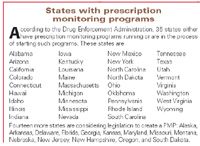Prescription monitoring programs are coming to a state near you
Once limited to just a few states, prescription drug monitoring programs are now up and running or in the offing in many states.

Pharmacists and physicians are making use of these programs. The Alabama program, which began allowing medical professionals access to the PMP database in August (15 months after the program started), reported that more than 30,000 inquiries have been made to its database of 20 million scripts.
These programs can be valuable, said Chris Herndon, Pharm.D., a pain management specialist and a member of the advisory board of the Alliance of State Pain Initiatives (ASPI), at the University of Wisconsin. "They can reduce the potential liability of pharmacists and physicians in filling and prescribing these drugs," he said, by providing access to information about patient drug use patterns. "If the information is available for improved clinical care, not just for regulatory scrutiny, pharmacists should support its use."
Reactive PMPs that generate solicited reports only in response to a specific inquiry made by a prescriber, dispenser, or other party with appropriate authority.

Although PMP legislation does not directly mandate that pharmacists report suspicious prescribing patterns, the proliferation of such programs increases the likelihood it will do so, said Catizone.
According to ASPI, PMPs are proliferating due to increases in prescription diversion. "ASPI does not oppose PMP programs per se," according to a January 2008 statement. "(But) it believes that states should only adopt programs that are balanced and address all sources of diversion, while not interfering with the use of controlled substances for legitimate purposes."
To that end, the ASPI statement calls on state legislatures to ensure that programs are "administered by a state agency responsible for regulating health care rather than by the agency responsible for enforcing the laws of the state." The 2005 National All Schedules Prescription Electronic Reporting Act authorized a system of federally funded, interoperative, state-based prescription drug monitoring programs. The law focused on the creation of electronic prescription databases as public health intervention tools, but no funding was provided.
Congress did, however, fund a Department of Justice program that emphasized the law enforcement aspects of prescription drug diversion and abuse, and states have been using those funds to create PMPs. According to some pain management professionals, that has meant that PMPs have been geared towards law enforcement, not public health intervention.
Whether they are designed to promote public health or prevent drug diversion, PMPs are coming to a state near you.
THE AUTHOR is a writer based in Gettysburg, Pa.
How PBMs Impede Pharmacists’ Ability to Perform Clinical Services | APhA 2025
March 31st 2025Antonio Ciaccia, President of 3 Axis Advisors, led a discussion on pharmacy benefit manager reform and how the inability to pass legislation has led to increased financial hardships in community pharmacy.